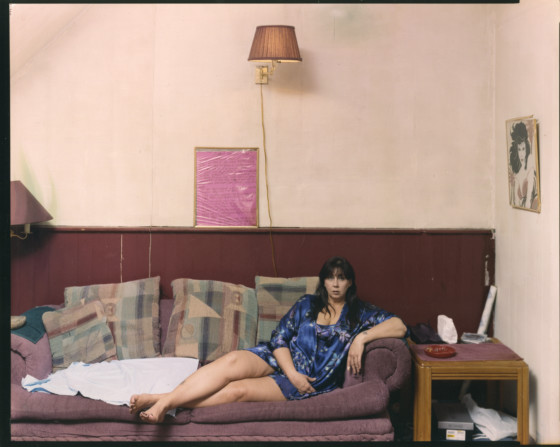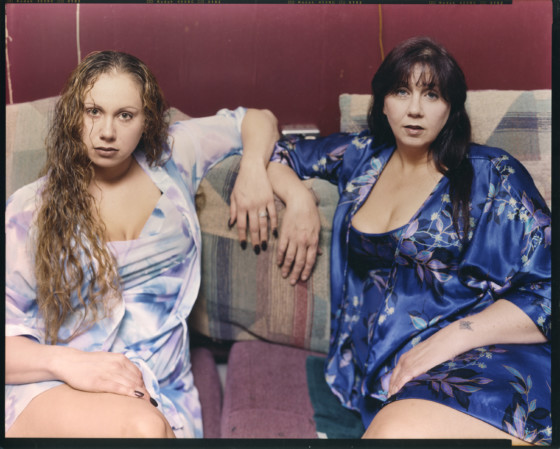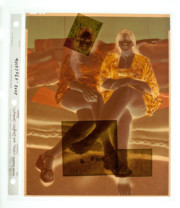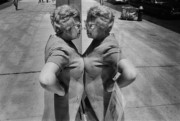Making the Image: Mother and Daughter by Alec Soth
The photographer explains how the 'key image' from his book, Sleeping by the Mississippi, came to be made
Contact sheets: direct prints of sequences of negatives were – in the pre-digital era – key for photographers to be able to see what they had captured on their rolls of film. They formed a central part of editing and indexing practices, and in themselves became revealing of photographers’ approaches: the subtle refinements of the frame, lighting and subject from photograph to photograph, tracing the image-maker’s progress toward the final composition that they ultimately saw as their best. There is a voyeuristic aspect to looking at a contact sheet also: one can retrace the photographer’s movements through time and space, tracking their eye’s smallest twitches from left to right as their attention is drawn. It is as if one were inside their head, offered a privileged view through their very eyes from the front row of their brain.
As Kristen Lubben wrote in her introduction to the book, Magnum Contact Sheets, first published in 2011 by Thames and Hudson:
“Unique to each photographer’s approach, the contact is a record of how an image was constructed. Was it a set-up, or a serendipitous encounter? Did the photographer notice a scene with potential and diligently work it through to arrive at a successful image, or was the fabled ‘decisive moment’ at play? The contact sheet, now rendered obsolete by digital photography, embodies much of the appeal of photography itself: the sense of time unfolding, a durable trace of movement through space, an apparent authentication of photography’s claims to transparent representation of reality.”
You can read other entries in Magnum’s series on contact sheets, and the making of iconic images here.
Sleeping by the Mississippi, Alec Soth‘s first photobook project, is comprised of images made during his travels along that storied river’s course. The project saw the photographer using the river’s winding course as a metaphor for his own wandering, from Minnesota down southward toward the river’s mouth, using the river as a guide. The project’s making was influenced by an air of freedom, ‘In a boyish – I want to go rafting down the river, sort of way,’ Soth explains. This sense of freedom was further fed by the work being made during a period of the Soth’s life which he considers uniquely suited to the task: a point at which he had the photographic skills to make work he liked, but was yet to gain an audience or following that could exert pressure upon him. So, he wandered through America unfettered by expectation.
One of the key images from Sleeping by the Mississippi – according to Soth – is his portrait of a mother and daughter side by side on a sofa. The picture was made in a brothel in Davenport, Iowa. Here, Soth explains how the image came to be made. You can see the final image from the book at the bottom of this page.
Our latest online education course, Alec Soth: Photographic Storytelling, sees the photographer discussing numerous of his books, including Sleeping by the Mississippi, at length. You can find out more about the new course on the Magnum Learn site.
“I was working on Sleeping by the Mississippi – a project along the entire Mississippi River. While I was in Davenport, Iowa, I saw a building that clearly looked like a brothel. I was just curious. I got up my nerve and went inside. A little old lady worked the front desk. I told her that I was a photographer and that I would pay to take pictures. She said, ‘No need to pay. It’s good advertising.’ I spent hours there. I photographed the various rooms. I photographed several clients. And I photographed a variety of women, including this mother and daughter.
I was working with an 8×10-inch view camera, which is a slow process and also expensive, so I wouldn’t shoot much. But when something was really juicy, I’d take a few more exposures. It’s impossible to explain why I chose the final frame. It’s like asking a painter, why did you choose that stroke? It just felt right. It’s incredible how subtle and intuitive these decisions can be.
The portrait turned out to be one of the key pictures in Sleeping by the Mississippi, and it’s been exhibited around the world. There’s a toughness and a vulnerability to it. A couple of years ago a newspaper in Iowa contacted me. They wanted to meet and interview the women, but I didn’t give him their information. I once sent them a copy of the picture, but I have no idea what they thought of it. I don’t know if they even know about the book. When I was working on the project, I used to have the models write down their ‘dream’ on a sheet of paper. The mother didn’t do it: ‘I’m too old for dreams,’ she said. But the daughter did write on the sheet. She said her dream was to be a registered nurse.”




















